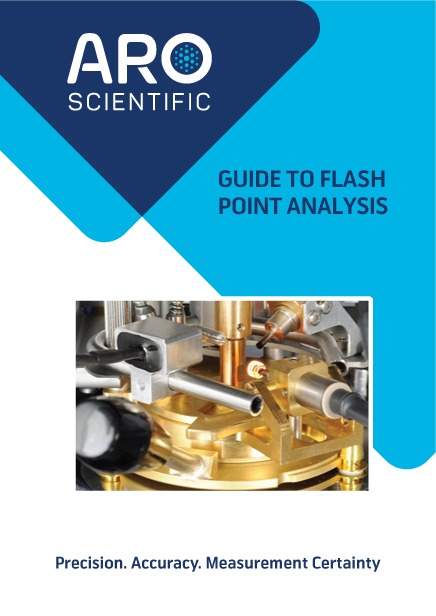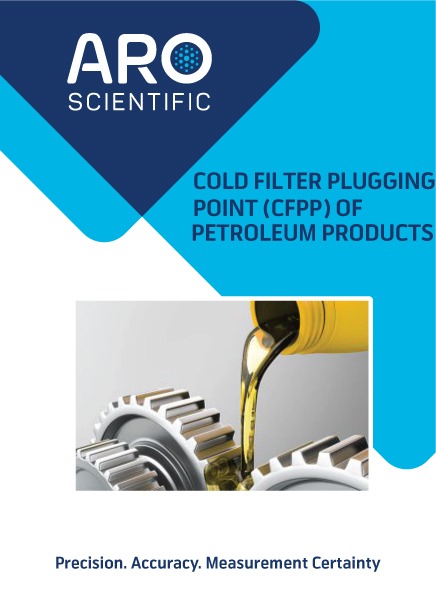Guide to Flash Point Analysis

Introduction
Flash point analysis is a crucial process in various industries, including oil and gas, chemicals, and transportation. It is a method used to determine the lowest temperature at which a substance can produce enough vapour to ignite in the presence of an ignition source. Understanding flash point is essential for ensuring safety in handling and storage of flammable substances. This guide will provide you with everything you need to know about flash point analysis, including its importance, testing methods, standards, and the use of flash point certified reference materials. Whether you are a scientist, engineer, or safety professional, this guide will equip you with the knowledge and tools to effectively perform flash point analysis and mitigate potential hazards.
What is flash point analysis?
Flash point analysis is a laboratory testing process used to determine the lowest ignition temperature at which a substance can produce enough vapour to ignite in the presence of an ignition source. It is an essential method for assessing the flammability and volatility of various liquids and solids. By identifying the flash point of a substance, professionals in industries such as oil and gas, chemicals, transportation, and many others can make informed decisions regarding handling, storage, and transportation protocols.
During flash point analysis, a sample is heated in a controlled environment until its vapours ignite when exposed to an ignition source such as an open flame or spark. This temperature, known as the flash point, is measured using specialised equipment such as a flash point tester or apparatus. The results of flash point analysis can be used to classify substances into different hazard classes, ensuring proper safety measures are in place to prevent accidents and protect personnel and facilities.
The importance of flash point analysis in various industries
Flash point analysis plays a pivotal role in several industries, making it a crucial testing method.
Oil and Gas: Flash point analysis helps determine the volatility of fuels and lubricants, allowing for safe storage and transportation practices. By identifying the flash point of different petroleum products, the industry can establish guidelines to prevent accidents and minimise the risk of fires.
Chemical: Flash point analysis ensures the safe handling and storage of chemicals, helping assess their potential for combustion or explosion. It aids in classifying hazardous substances and implementing suitable mitigation measures during manufacturing, storage, and transport.
Transportation: For shipping flammable liquids or gases, flash point analysis is crucial in determining the appropriate packaging, labelling, and handling procedures. It ensures compliance with regulatory requirements and guarantees the safety of personnel and assets during transportation.
In conclusion, flash point analysis is a vital tool in numerous industries, providing valuable insights into the flammability and volatility of various substances. Its application allows for the implementation of necessary safety measures, preventing accidents and safeguarding personnel and facilities.
Understanding the key components of flash point analysis
To fully grasp the concept of flash point analysis, it is essential to understand its key components.
Test Method: Flash point analysis employs various test methods, including open cup flash point and closed cup flash pooint methods. Each method has its own set of protocols and apparatuses, but they all aim to determine the temperature at which a substance gives off enough vapours to ignite when exposed to an ignition source.
Sample Preparation: Before conducting the test, proper sample preparation is necessary. This involves ensuring the sample is representative and free from any impurities that could affect the accuracy of the results. Additionally, it is important to follow specific guidelines for sample size and test conditions to guarantee consistent and reliable outcomes.
By understanding these key components of flash point analysis, professionals in various industries can effectively use this testing method to ensure safety and compliance with relevant regulations.
Flash Point Standard Test Methods for Reliable Analysis
International standard test methods play a vital role in for flash point analysis. These standards are established and published by recognised bodies such as the American Society for Testing and Materials (ASTM), Energy Institute (EI), the International Organisation for Standardisation (ISO), and other recognised bodies.
The international standard test methods published specify the methods and techniques used for determining flash point
Abel Closed Cup
IP 170, ISO 13736. These international standard test methods are designed specifically for use in determining the flash point using the Abel Closed Cup flash point procedures.
Cleveland Open Cup (COC)
ASTM D92, IP 36, ISO 2592, EN 2592. These international standard test methods are designed specifically for use in determining the flash point using the Cleveland Open Cup (COC) flash point procedures.
Pensky-Martens Closed Cup (PMCC)
ASTM D93, IP 34, ISO 2719. These international standard test methods are designed specifically for use in determining the flash point using the Pensky-Martens Closed Cup (PMCC) flash point procedures
Tag Closed Cup
ASTM D56. This international standard test method is designed specifically for use in determining the flash point using the Tag Closed Cup flash point procedures.
There are other flash point test methods available, such as ASTM D3934, ASTM D3941, ASTM E502, IP 491, IP 492, ISO 1516, ISO 1523, IP 491, IP 492, ISO 5123, ISO 1376, etc.
Conducting flash point testing: Methods and procedures
Conducting flash point testing requires following specific methods and procedures to obtain accurate and reliable results. There are two main test methods commonly used in flash point analysis: open cup and closed cup methods.
The open cup flash point method involves exposing the sample to an open container and gradually increasing its temperature, using an open flame as an ignition source. As the temperature rises, the vapor released from the sample may ignite, indicating the flash point.
On the other hand, the closed cup flash point method involves a sealed container, preventing the sample from being in contact with the open flame. This method typically uses an electrically heated element to raise the temperature of the sample. The flash point is determined by using a detection apparatus, such as a spark igniter, to detect the presence of vapor ignition.
Regardless of the method chosen, it is crucial to strictly adhere to the prescribed procedures to ensure accuracy and consistency. This includes following the specified heating rate, recording the temperature at which ignition occurs, and repeating the test multiple times to confirm the results.
By implementing the appropriate methods and procedures, professionals can effectively conduct flash point testing and obtain valuable data to inform decisions related to safety, storage, and transportation of flammable substances.
Interpreting flash point analysis results
Interpreting the results of flash point analysis is essential in understanding the properties and potential hazards of flammable substances. The flash point is a crucial parameter that helps identify the minimum temperature at which a substance emits enough vapor to ignite when exposed to an ignition source.
A substance with a low flash point indicates a higher risk of flammability, making it more dangerous to handle and store. Conversely, a substance with a high flash point is less likely to ignite and is considered safer.
It is important to note that flash point alone does not determine a substance's overall flammability. Other factors, such as vapor pressure, volatility, and the presence of additives or contaminants, can also impact the flammability of a substance.
Understanding the significance of flash point test results allows professionals to make informed decisions regarding the storage, transportation, and handling of flammable substances. In the following section, we will delve deeper into the implications of flash point data and explore how it can be used to ensure safety in various industries.
Common challenges and troubleshooting in flash point analysis
While flash point analysis is a valuable tool for assessing the flammability of substances, it does come with its own set of challenges. To ensure accurate and reliable results, it is important to be aware of potential issues that may arise during the analysis process.
One common challenge is sample contamination. Contaminants, such as residual solvents or impurities, can lower the flash point of a substance, leading to inaccurate results. To avoid this, it is crucial to properly clean and prepare the samples before testing.
Another challenge is the presence of additives or inhibitors in the sample. These substances can affect the flash point, making it challenging to determine the true flammability of the material. In such cases, it may be necessary to conduct additional tests to accurately assess the hazards.
Additionally, the selection of the appropriate testing method and equipment is essential. Different test methods, such as open cup and closed cup, may yield varying results. It is important to choose the method that is most suitable for the substance being tested.
The benefits of integrating flash point analysis in your laboratory or facility
In addition to understanding the challenges associated with flash point analysis, it is essential to recognise the numerous benefits that come from integrating this analysis into your laboratory or facility. Flash point analysis provides valuable information about the flammability of substances, allowing you to make informed decisions and ensure safe handling and storage practices.
One major benefit is the ability to assess the potential fire hazards associated with a substance. By knowing the flash point, you can determine the minimum temperature at which a substance can ignite, helping you establish appropriate safety measures and guidelines.
Moreover, flash point analysis helps in identifying the correct storage and transportation requirements for substances. Understanding the flammable properties of materials allows for the proper selection of containers, labelling, and handling procedures, reducing the risk of accidents and ensuring compliance with regulations.
Additionally, integrating flash point analysis in your laboratory or facility can enhance quality control processes. By regularly testing substances, you can ensure that they meet industry standards and specifications, guaranteeing the safety and reliability of the final products.
Conclusion: Utilising flash point analysis for safety and quality assurance
In conclusion, flash point analysis is a crucial tool for ensuring safety and quality in various industries. By integrating this analysis into your laboratory or facility, you can accurately assess the fire hazards associated with substances and establish appropriate safety measures. Additionally, it allows for the identification of correct storage and transportation requirements, reducing the risk of accidents and ensuring compliance with regulations. Moreover, regular flash point testing enhances quality control processes, ensuring that substances meet industry standards and specifications.
The use of CRMs provides a known reference point for comparing the measurement results obtained from the CRM to the certified values, the accuracy and reliability of the measurement system can be assessed and adjusted if necessary.
ISO 17034 accreditation of the reference material producer benefits users of reference materials as it provides confidence in the competence of the producer to characterise such materials.
ARO Scientific offer a range of Abel Closed Cup, Cleveland Open Cup, Pensky-Martens Closed Cup and Tag Closed Cup flash point Certified Reference Materials and Secondary Working Standards.
ARO Scientific Ltd holds dual accreditation status under The United Kingdom Accreditation Service (UKAS) to international standards ISO/IEC 17025 and ISO 17034, CAB No. 27393. The UKAS mark ensures buyers have peace of mind. ILAC also bridges international barriers, making trade easier, especially in new growth markets. Our Combined UKAS and ILAC-MRA Mark demonstrates that the accreditation we hold is recognised under the International Laboratory Accreditation Cooperation (ILAC) Mutual Recognition Arrangement, our certificates are accepted around the world.
Quality Commitment
ARO Scientific Ltd recognises that our customers should be always provided with products and services they can reply upon, trust and have confidence to use on a daily basis. Our commitment to quality and our accreditations demonstrates that we have rigorous quality systems in place that allow us to provide customers with the highest quality products possible, which are accepted globally.









